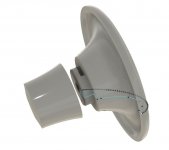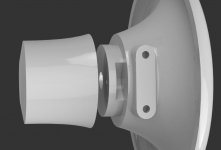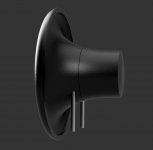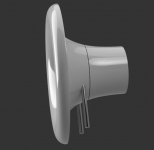Unfortunately only for two bolts (at ⌀76 mm) - there's is not enough space for more (3x at ⌀57).
Last edited:
Very nice.
Look out for "tune-forking"... (yes I'm generally suspicious and negative thinking 🙂)
//
Look out for "tune-forking"... (yes I'm generally suspicious and negative thinking 🙂)
//
Presumably either the woofer or WG frequency response must have altered.
Did you determine which was responsible?
Is diffraction from the woofer frame and surround detectable when it's recessed to match as neatly as shown in the picture?
No to the first question (many things changed) and I have no idea to the second.
But you will notice that the results for the NA12 are very good, so we are looking at very small effects. These kinds of small details are hard to evaluate. Sure one can "guess" at the answers, but to state definitively is extremely hard to do. And you seem the type to reject any hypotheses that are not "proven".
Porous walls or internal volume or both? Why not print porous waveguide - will be slow but doable.
Give it a try.
Back to the guestion between flat DI or slightly rising one. A paper was posted on another thread
https://www.sausalitoaudio.com/wp-content/uploads/2018/07/Interpreting-Spinorama-Charts.pdf
And a quote from page 17:
"... if the axial response is substantially flat,
the inverse of the directivity index gives a useful approximation of
how the speaker will measure in a room – of any size."
If this is true then people who would like a bit downward sloping response on a speaker would prefer the slightly risin DI waveguide since it would have downward sloping power response? But, when the DI is flat, the power is also flat if the on axis response is flat? This one would be outside of the circle of confusion, the flat? 🙂
https://www.sausalitoaudio.com/wp-content/uploads/2018/07/Interpreting-Spinorama-Charts.pdf
And a quote from page 17:
"... if the axial response is substantially flat,
the inverse of the directivity index gives a useful approximation of
how the speaker will measure in a room – of any size."
If this is true then people who would like a bit downward sloping response on a speaker would prefer the slightly risin DI waveguide since it would have downward sloping power response? But, when the DI is flat, the power is also flat if the on axis response is flat? This one would be outside of the circle of confusion, the flat? 🙂
Last edited:
If the axial response is substantially flat, the inverse of the directivity index is simply the power response. This is not the same as the in-room response but close.
Sure, this is still the same debate we had earlier. I'm only not sure I follow what you say of being "outside the circle of confusion".
Sure, this is still the same debate we had earlier. I'm only not sure I follow what you say of being "outside the circle of confusion".
Last edited:
I guess I was thinking that when the speaker is truly flat in the room the speaker isnoutside of the circle of confusion not contributing to it. Had some wine so cannot trace back the exact thought 😀 well, carry on
Audio Musings by Sean Olive: Audio's Circle of Confusion
1.4 Preserving the Art—The Circle of Confusion - in Sound Reproduction 3rd Edition Floyd Toole.
1.4 Preserving the Art—The Circle of Confusion - in Sound Reproduction 3rd Edition Floyd Toole.
Finally, Ath 4.7.0 has been released.
It's all about the circular symmetry (CircSym) mode and I strongly encourage everyone to start using the latest version. This is probably the biggest advancement since the very first release and I expect to see some great designs.
You can download the program at ATH - Advanced Transition Horns.
It's all about the circular symmetry (CircSym) mode and I strongly encourage everyone to start using the latest version. This is probably the biggest advancement since the very first release and I expect to see some great designs.
You can download the program at ATH - Advanced Transition Horns.
- Home
- Loudspeakers
- Multi-Way
- Acoustic Horn Design – The Easy Way (Ath4)



